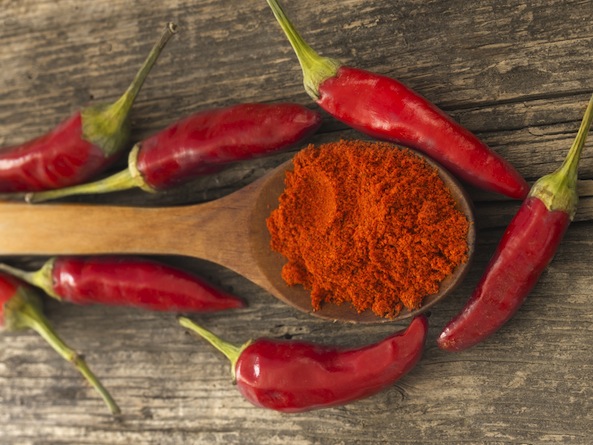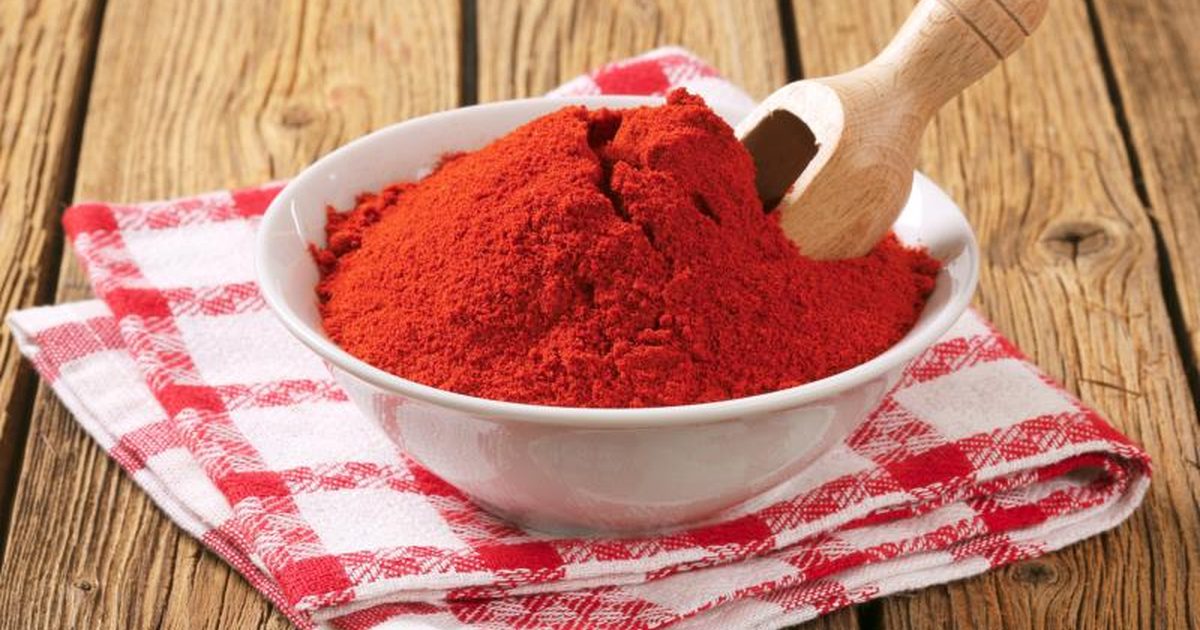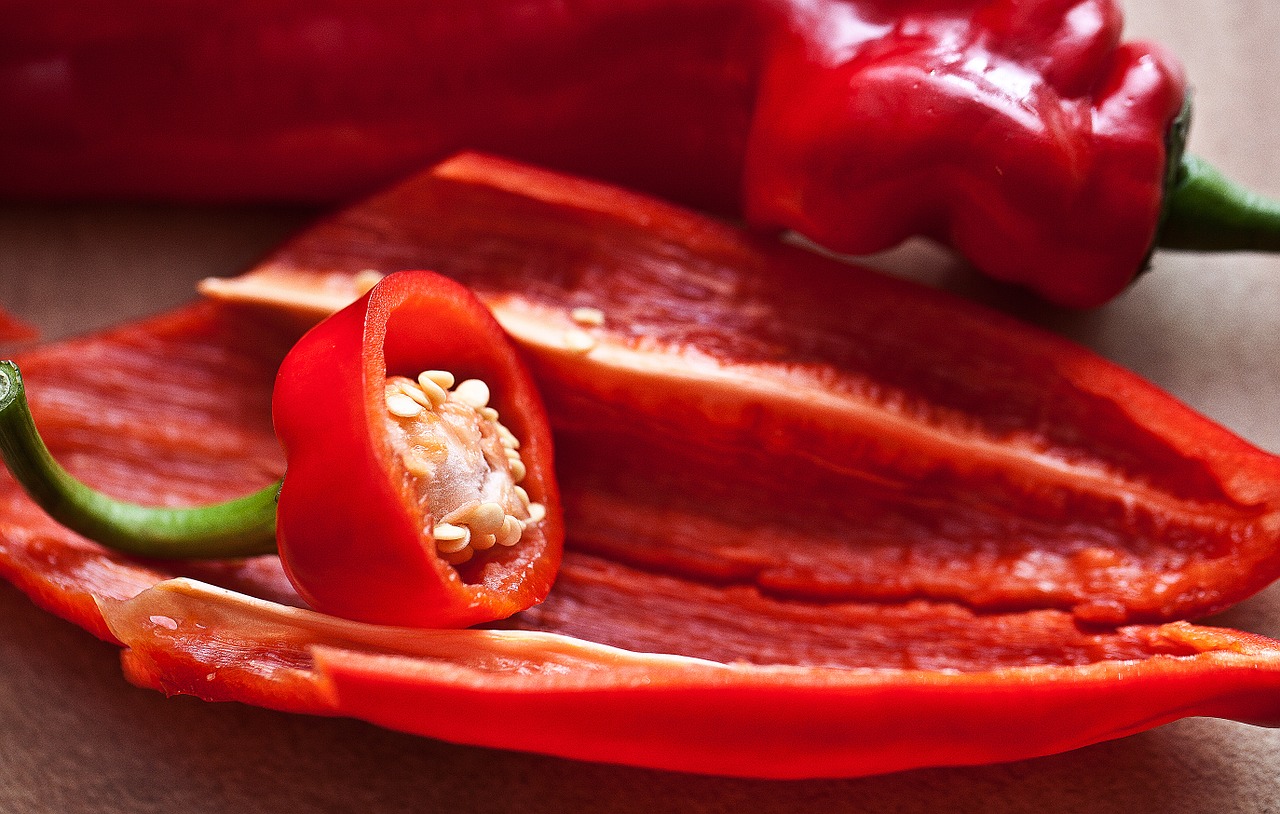
Adding that little bit of spice into your dishes may be the best decision you make for your family; and what better hot spice to use than cayenne pepper. Cayenne pepper supposedly originated from the Cayenne region of French Guiana in South America (hence the name). However, it is now largely grown in India, East Africa, Mexico and the United States. It is generally dried and ground, or pulped and baked into cakes, which are then ground and sifted to make the powdered spice. However, the pepper is also used in their whole form in Korean, Sichuan and other Asian cuisines.
Cayenne pepper, scientifically known as Capsicum Frutescens, is from the Capsicum genus in the nightshade family of Solanaceae. It is also known as guinea pepper, bird’s beak, chilliepin and mad pepper and is generally rated at 30,000 to 50,000 on the Scoville scales. The Scoville scale is a measurement of the pungency (spicy heat) of chilli peppers. This measurement means it is as hot as Tabasco pepper and the yellow lantern chilli.

Cayenne pepper has been used as medicine for over 9000 years and many herbalists believe that Cayenne is the most useful and valuable herb in the herb kingdom, not only for the entire digestive system, but also for the heart and circulatory system. It acts as a catalyst and increases the effectiveness of other herbs and nutrients when used with them. For example, if you were to add cayenne pepper in a glass of orange juice it would increase the potency of the vitamin C in that drink giving you a great remedy for colds and flu.
Capsaicin is the active ingredient in cayenne pepper and it gives the powder its spiciness. It is also thermogenic, elevating the body's temperature, which boosts metabolism. According to a study in South Korea, cayenne can also aid weight loss by stimulating carbohydrate oxidation during rest and exercise. This means that the body is able to burn more carbohydrates. The more carbohydrates that are burned the less is stored as fat.
Cayenne has traditionally been used for overcoming fatigue and restoring stamina and vigour. It is a natural stimulant without the threatening side effects of palpitations, hyperactivity or rise in blood pressure like many other stimulating agents. This stimulating effect also "orders" the brain to burn fat cells, especially fat cells around the midriff or stomach area, according to Stephen Whiting, a food scientist. He also mentions the potential benefit of cayenne pepper in weight management by increasing energy expenditure (burning more energy), increasing lipid oxidation (burning more fats) and reducing appetite.
Cayenne is a medicinal and nutritional herb. It is a very high source of Vitamins A, C, E, has the complete B complexes, and is very rich in organic calcium, potassium and manganese, which is one of the reasons it is good for the heart. It is said to have no equal for its ability to boost circulation and increase heart action, even stopping a heart attack within 30 seconds! Doctors would achieve this by giving the patient a tea made by simply mixing one teaspoon of cayenne pepper in a cup of hot water. This exerts a variety of desirable actions on the entire cardiovascular system. It has the extraordinary ability to enhance cardiovascular performance while actually lowering blood pressure.
Capsaicin's powerful decongestant properties stimulate the release of mucus from respiratory passages, which in turn opens the airway. It also dilates blood vessels and increases blood flow to major organs, which means it allows for more nutrients and oxygen to enter vital areas of the body encouraging healing.
Externally, it can be applied on the skin as a remedy for conditions involving joint pains (such as in the case of rheumatoid arthritis and osteoarthritis). It achieves this by causing the body to be ‘distracted’ by the original pain, known as the ‘counter-irritant’ effect. It also causes the brain to secrete more endorphins, the ‘feel good’ hormone, thus lowering the sensation of pain.
Research has particularly shown the effectiveness of capsaicin in treating cluster headaches. A study published in Cephalalgia found that it can desensitize sensory neurons by depleting the nerve terminals of substance P, a neuropeptide associated with inflammatory processes and pain. It is also a chemical that carries pain messages to the brain. Thus, with less substance P, fewer pain messages reach the brain and less pain is felt. The authors of the study concluded that taking capsaicin through the nasal passage may provide an effective treatment option for these headaches. This makes it an ideal pain killer for other pains such as migraines, stomach-aches, cramps, etc. Applying cayenne pepper as a poultice (see Recipes for Health) on the area of pain should also provide the same effect.
A study published in the Journal of the American Academy of Dermatology, found that cayenne pepper, when applied topically (on the affected area of the skin, i.e. as a poultice), can significantly improve itching and other symptoms associated with psoriasis.
The interesting thing about cayenne pepper is that internally it dilates blood vessels but when applied to open wounds it seals the wound and halts blood flow. By simply sprinkling some cayenne pepper on the open wound it will almost instantly stop the bleeding. Be aware, it will sting!
The American Journal of Clinical Nutrition published a study, which suggested cayenne pepper could aid those with diabetes. They found that diabetic people who ate a meal containing liberal amounts of chilli pepper required less insulin (to reduce their blood sugar) after the meal.
Cayenne can rebuild the stomach tissue and boost the peristaltic action in the intestines. It aids elimination and assimilation (especially of proteins), and helps the body to create hydrochloric acid (stomach acid), which is essential for good digestion. Cayenne pepper can also help produce saliva by stimulating the salivary glands and the flow of enzyme production. This, in turn, can also aid in combating bad breath.
Studies conducted around the world, suggests that cayenne pepper can cause remarkable results in cancer patients. One study, conducted by the American Association for Cancer Research, reports that capsaicin is able to kill prostate cancer cells by forcing them to undergo "apoptosis"' a form of cellular self-termination, without harming any health cells around them. Another study conducted at the University of Nottingham in England strongly suggests that capsaicin is able to trigger apoptosis in lung and pancreatic cancer cells. There have also been several clinical studies conducted in Japan and China that showed natural capsaicin directly inhibits the growth of leukemic cells as well.

Cayenne pepper is possibly the king of herbs with the amazing effects it can have on our health and its ability to treat a whole host of conditions. Many are avid drinkers of the cayenne pepper tonic to detoxify, repair and revitalise the body. Others use it to treat long standing conditions that no other remedy has been able to do. It is important to note that as a beginner it is best to start with a pinch of cayenne pepper in hot water and then work your way up to 1 teaspoon. The warmer the water the better, as it increases its potency. Taking this tea at a time that you are relaxed is better and will avoid any feelings of nausea. The slight tingling on the tongue is nothing compared to the vast amounts of benefits you can achieve from taking it.
Recipes for Health
Immune boosting tonic
1/4 teaspoon of cayenne pepper;
1/4 teaspoon of ground ginger;
1 tablespoon of honey;
1 tablespoon of apple cider vinegar;
2 tablespoons of water (hot or cold).
Making it into a hot tea will clear the sinuses. The cayenne pepper in this tonic will increase the effectiveness of all the other ingredients boosting its antibiotic abilities. Other ingredients such as garlic and lemon juice can also be added.
Cayenne pepper poultice
1) Lay a piece of cling film out on the table.
2) Fold a kitchen roll paper in half and place on top of the cling film.
3) Sprinkle a small amount of olive oil on the kitchen paper and spread out.
§ Olive oil is used so that cayenne pepper will stick to it.
4) Sprinkle cayenne pepper on the oil generously.
5) Put the poultice on the area of pain.
6) Wrap cling film around the area and keep it warm.
7) Leave it on for a few hours or overnight.
8) May not experience heat or warmth immediately.
Sources
https://en.m.wikipedia.org/wiki/Cayenne_pepper
https://en.m.wikipedia.org/wiki/Scoville_scale
http://theepicentre.com/spice/cayenne-pepper/
http://www.globalhealingcenter.com/natural-health/benefits-of-cayenne-pepper/
http://www.medicalnewstoday.com/articles/267248.php
http://www.rd.com/health/conditions/health-benefits-cayenne-pepper/
http://www.shirleys-wellness-cafe.com/NaturalFood/Cayenne
http://www.cayennepepper.info/
Http://cancerres.aacrjournals.org/cgi/content/full/66/6/3222
http://news.bbc.co.uk/2/hi/health/6244715.stm
http://www.eurekalert.org/pub_releases/2006-03/aafc-pch031306.php
Lim, K., et al. (1997). Dietary red pepper ingestion increases carbohydrate oxidation at rest and during exercise in runners. Med Sci Sports Exerc 1997; 29(3): 355-61.
Yoshioka M., et al. (1995). Effects of red-pepper diet on the energy metabolism in men. J Nutr Sci Vitaminol 1995; 41(6): 647-56.
Whiting S, Derbyshire E, Tiwari BK. Capsaicinoids and capsinoids. A potential role for weight management? A systematic review of the evidence. Appetite 2012; 59(2): 341-8.
doi: 10.1016/j.appet.2012.05.015. Epub 2012 May 22.
Todd C. Meeting the therapeutic challenge of the patient with osteoarthritis. J Am Pharm Assoc 2002; 42: 74-82.
Marks DR, Rapoport A, Padla D, et al. A double-blind placebo-controlled trial of intranasal capsaicin for cluster headache. Cephalalgia 1993; 13: 114-116.
Keitel W, Frerick H, Kuhn U, Schmidt U, Kuhlmann M, Bredehorst A. Capsicum pain plaster in chronic non-specific low back pain. Arzneimittelforschung 2001; 51: 896-903.
Ellis CN, Berberian B, Sulica VI, et al. A double-blind evaluation of topical capsaicin in pruritic psoriasis. J Am Acad Dermatol 1993; 29: 438-442.
Bernstein JE, Parish LC, Rapaport M, et al. Effects of topically applied capsaicin on moderate and severe psoriasis vulgaris. J Am Acad Dermatol 1986; 15: 504-507.
Reimann S, Luger T, Metze D. Topical administration of capsaicin in dermatology for treatment of itching and pain. Hautarzt 2000; 51: 164-172.
Akio Mori et al. Capsaicin, a Component of Red Peppers, Inhibits the Growth of Androgen-Independent, p53 Mutant Prostate Cancer Cells. Cancer Research 2006; 66: 3222-3229.
